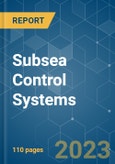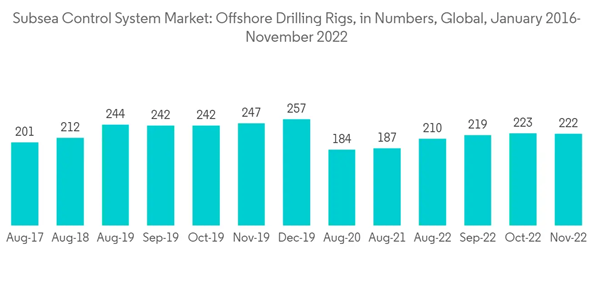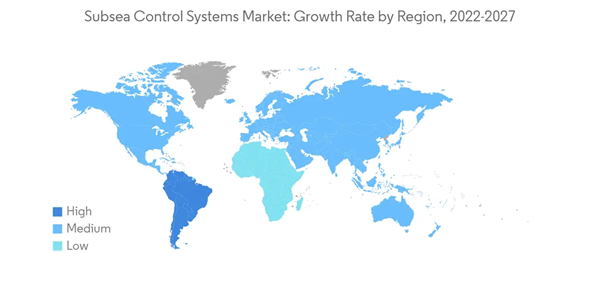The Subsea Control Systems Market is projected to register a CAGR of over 2% during the forecast period.
COVID-19 negatively impacted the market in 2020. Presently the market has now reached pre-pandemic levels.
This product will be delivered within 2 business days.
COVID-19 negatively impacted the market in 2020. Presently the market has now reached pre-pandemic levels.
Key Highlights
- Factors such as deep-water and ultra-deep-water exploration and production are likely to drive the subsea control systems market in the forecast period.
- On the flip side, harsh environmental conditions will make installing, maintaining, and replacing the subsea control systems difficult. This, in turn, is expected to restrain the market during the forecast period.
- Increasing deep-water activities in countries like Brazil, Egypt, the United States, Iran, and Qatar, is likely to create several opportunities for the subsea control systems market in the forecast period.
- South America has dominated the subsea control systems market, and most of the demand comes from Brazil due to its recent deep-water and ultra-deep-water activities. It is likely to dominate the market in the forecast period.
Subsea Control Systems Market Trends
Deep-water and Ultra Deep-water Likely to Dominate the Market
- The deep-water and ultra-deep-water activities directly influence the subsea control systems market offshore. After oil prices fell in 2014, many countries shifted toward onshore projects. Still, the return on the investment period of onshore projects is 10-15 years. Thus, the nations like Brazil, the United States, and Egypt started deep-water and ultra-deep-water explorations, which have a return period of 5-6 years, are more profitable, and are likely to drive the Subsea Control Systems Market in the forecast period.
- In July 2021, Reliance Industries Limited and BP PLC started production from the R Cluster, an ultra-deep-water gas field in Block KG D6. Both companies have further planned to develop two more deep-water gas projects, which are expected to meet ~15% of India’s gas demand by 2023.
- In April 2022, Saipem won a contract with the Italian oil and gas company Eni for the drilling campaign to be conducted using the ultra-deep-water drillship Saipem 12000 in west Africa.
- Between August 2016 to August 2022, the offshore drilling rig is 228 and 222, respectively. After 2016, the offshore rig count of the world increased significantly, primarily in 2019, i.e., 257, and is likely to impact subsea control systems as they are used offshore positively.
- As of 2021, the offshore oil and gas industry accounts for about 30% of global crude oil production. The major offshore oil and gas-producing regions are the Middle East, the North Sea, Brazil, the Gulf of Mexico, and the Caspian Sea. In addition, the availability of abundant resources, coupled with the increased potential to recover oil and gas from deepwater and ultra-deepwater areas, is expected to provide an excellent opportunity for the market studied.
- In January 2022, the Egyptian government awarded eight of the twenty-four blocks. Eni Spa received exploration licenses to five blocks, and the other bid winners were BP plc, Apex International Energy Management LLC, and United Energy Corp.
- Therefore, with the increase in deep-water and ultra-deep-water exploration and production activities, the subsea control systems will likely witness significant demand during the forecast period.
South America Expected to have Significant Growth
- South America has significant presence of deep-water and ultra-deep-water projects in the past decade and is likely to have more such projects during the forecast period as well. Since deep-water and ultra-deep-water directly influence the subsea control systems installations, South America is expected to dominate the subsea control systems market in the forecast period.
- In April 2022, Mero field, an ultra-deepwater oil field, achieved its first oil using the Floating Production, Storage, and Offloading Guanabara MV31 in Santos Basin, Brazil. The area is owned by the Libra consortium, which is led by CNODC (9.65%), TotalEnergies EP Brasil (19.3%), CNOOC (9.65%), Pré-sal Petróleo - PPSA (3.5%), Petrobras (38.6%), and Shell (19.3%).
- As of 2021, the Libra oil field in Santos Basin in Brazil is an ultra-deep-water basin. It is also the largest oil field in Brazil, which is under development. Projects are likely to have a positive impact on the subsea control systems market during the forecast period.
- In January 2022, Argentina's state-backed energy company YPF expects its first offshore project to produce up to 200,000 barrels per day, driving the demand for subsea control systems in the country.
- Hence, the factors mentioned above indicate that South America is expected to dominate the subsea control systems market in the forecast period due to its several upcoming deep-water and ultra-deep-water projects.
Subsea Control Systems Market Competitor Analysis
The Subsea Control Systems Market is moderately consolidated. Some of the key players in this market (not in particular order) include Schlumberger Limited (OneSubsea), TechnipFMC PLC, Deep Down Inc., Dril-Quip Inc., and Oceaneering International.Additional benefits of purchasing the report:
- The market estimate (ME) sheet in Excel format
- 3 months of analyst support
This product will be delivered within 2 business days.
Table of Contents
1 INTRODUCTION
4 MARKET OVERVIEW
5 MARKET SEGEMENTATION
6 COMPETITIVE LANDSCAPE
Methodology

LOADING...










